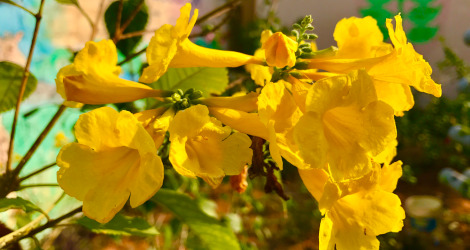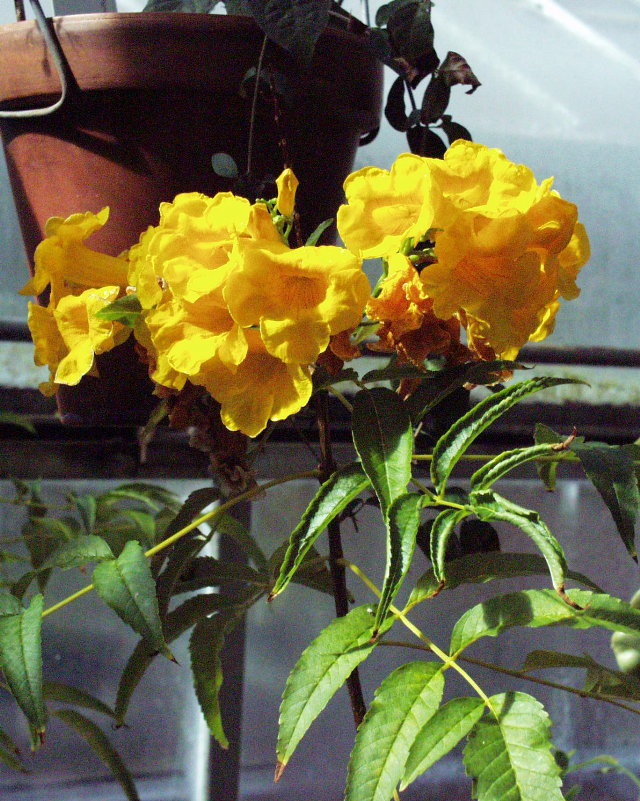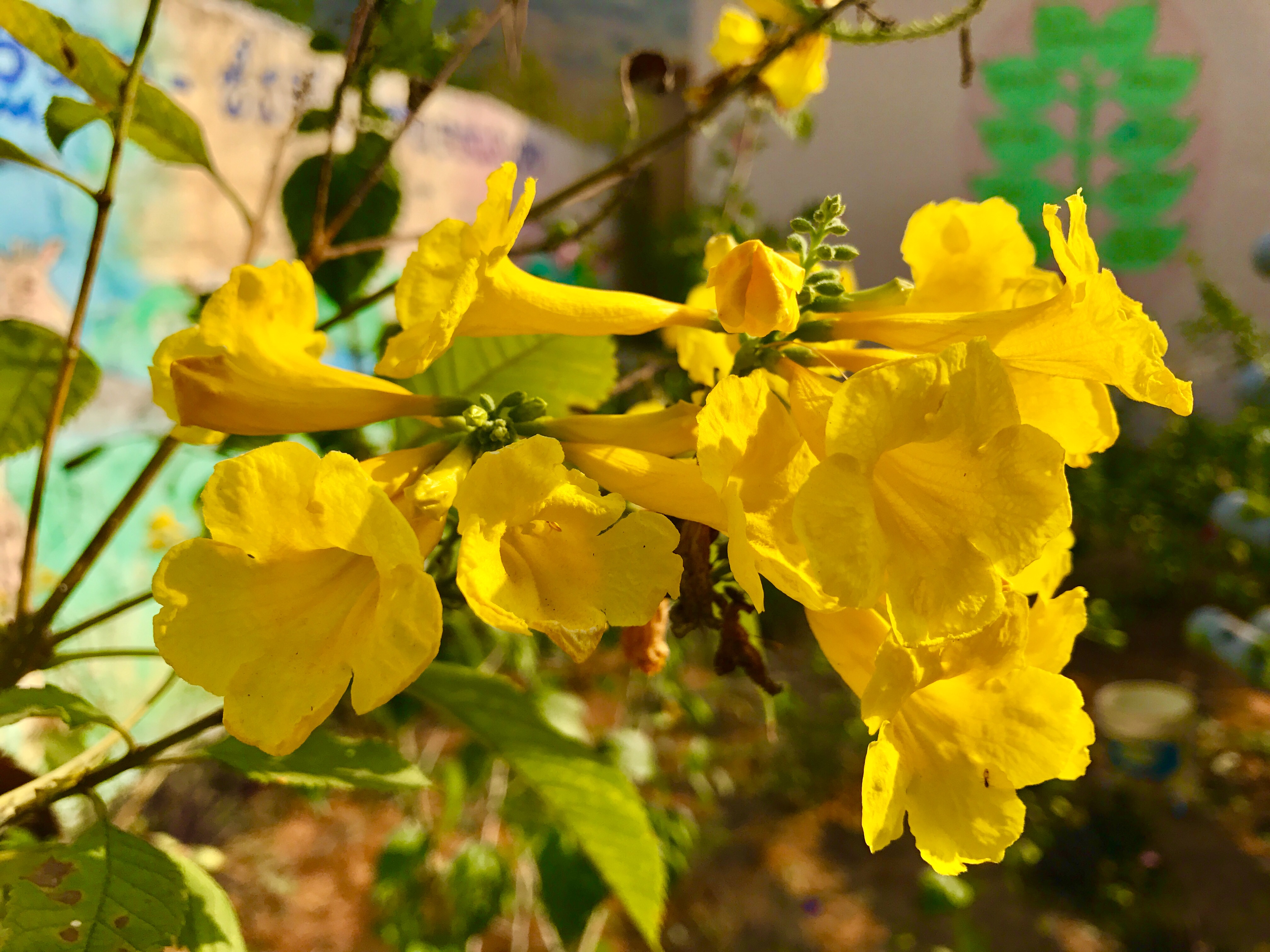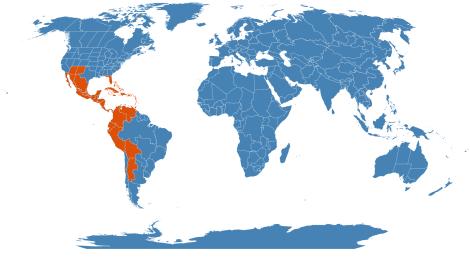Accession Data
Tecoma stans
Common Name: Yellow Bells
Family: Bignoniaceae
Country of Origin: tropical America
Description: "Shrub or small tree, much branched, twigs tan or reddish tan, smooth, scarcely 4-sided; leaves opposite, pinnately compound, leaflets 1-9, usually 3-7, ovate-lanceolate, apex acuminate, base acute or obliquely acute, very shortly petiolate or subsessile, slightly hirsute on midrib and in vein axils beneath, margins irregularly serrate, leaves quite variable, rachis and petiole slender, glabrous; inflorescence an axillary or terminal raceme, pedicels short, irregularly curved or twisted, bracts reduced to minute scales, flowers rather few, calyx narrowly cylindric-campanulate, 5-7 cm long, with 5 sub-equal acuminate teeth, glabrous; corolla bright yellow, narrowly campanulate, tube narrow, about 1 cm long, throat about 2.5 cm long, dorsiventrally compressed, with 2 longitudinal folds on ventral side, 5 sub-equal spreading orbicular lobes about 8 mm long, several faint diffuse reddish lines in throat; stamens 4, attached at summit of tube, in 2 unequal pairs, included, filaments pilose at base, curved above, anthers versatile, linear, yellow, pilose, 6 mm long; sterile fifth stamen much reduced; pistil about equaling stamens, ovary narrowly cylindric, about equaling calyx, style filiform, glabrous, stigma flat, elliptic; capsule linear, compressed, 10-20 cm long, 7-8 mm wide, brown when ripe, with raised line or suture lengthwise on each flat side, tardily dehiscent along suture, septum parallel with flat sides, firm, seeds flat, oblong, 7-8 x 4 mm, with a membranous transparent wing on each end, ends of wing erose, seeds entire including wing about 20 x 6 mm" (Fosberg et al, 1993).
Other Names: peeal (Puluwat), piti (French Polynesia)
Uses: Medicinal Properties: Studies have shown effectiveness as a diuretic, tonic, anti-syphilitic, and vermifuge.
Parts utilized: Entire plant.
Traditional Folk Uses: Roots are reported to be diuretic, tonic, anti-syphilitic and vermifuge. In Veracruz, decoction of flowers and bark are used for stomach pains. In some parts of Mexico and in central and south America, the plant is used in the treatment of diabetes.
Other Uses: In Guadalajara, roots used for making beer.
From Philippine Alternative Medicine
Accession Data
USDA Zone: 7-11
Accession #: 198500662
Accession Date: 1985-12-31 00:00:00
Bloom Status: 🪴 Not Flowering
Location: 1316
Quantity: 3
Source: Unknown
Culture: full sun, well drained soil with minimal water when not in active growth
Classification
Division: Magnoliophyta
Class: Magnoliopsida
Subclass: euasterid I
Order: Lamiales
Family: Bignoniaceae
Tribe: Tecomeae
Flowering Data:
This accession has been observed in bloom on:| Year | Jan | Feb | Mar | Apr | May | Jun | Jul | Aug | Sep | Oct | Nov | Dec | ||||||||||||||||||||||||||||||||||||||||
|---|---|---|---|---|---|---|---|---|---|---|---|---|---|---|---|---|---|---|---|---|---|---|---|---|---|---|---|---|---|---|---|---|---|---|---|---|---|---|---|---|---|---|---|---|---|---|---|---|---|---|---|---|
| 2025 | ||||||||||||||||||||||||||||||||||||||||||||||||||||
| 2024 | ||||||||||||||||||||||||||||||||||||||||||||||||||||
| 2023 | ||||||||||||||||||||||||||||||||||||||||||||||||||||
| 2022 | ||||||||||||||||||||||||||||||||||||||||||||||||||||
| 2021 | ||||||||||||||||||||||||||||||||||||||||||||||||||||
| 2020 | ||||||||||||||||||||||||||||||||||||||||||||||||||||
| 2019 | ||||||||||||||||||||||||||||||||||||||||||||||||||||
| 2018 | ||||||||||||||||||||||||||||||||||||||||||||||||||||
| 2017 | ||||||||||||||||||||||||||||||||||||||||||||||||||||
| 2016 | ||||||||||||||||||||||||||||||||||||||||||||||||||||
| 2015 | ||||||||||||||||||||||||||||||||||||||||||||||||||||
| 2014 | ||||||||||||||||||||||||||||||||||||||||||||||||||||
| 2013 | ||||||||||||||||||||||||||||||||||||||||||||||||||||
| 2012 | ||||||||||||||||||||||||||||||||||||||||||||||||||||
| 2011 | ||||||||||||||||||||||||||||||||||||||||||||||||||||
| 2010 | ||||||||||||||||||||||||||||||||||||||||||||||||||||
| 2009 | ||||||||||||||||||||||||||||||||||||||||||||||||||||
| 2008 | ||||||||||||||||||||||||||||||||||||||||||||||||||||
| 2007 | ||||||||||||||||||||||||||||||||||||||||||||||||||||
| 2006 | ||||||||||||||||||||||||||||||||||||||||||||||||||||
| 2005 | ||||||||||||||||||||||||||||||||||||||||||||||||||||
| 2004 | ||||||||||||||||||||||||||||||||||||||||||||||||||||
| 2003 | ||||||||||||||||||||||||||||||||||||||||||||||||||||
References
- Fosberg, F. R.; M.-H. Sachet and R. L. Oliver. 1993. Flora of Micronesia. Part 5. Bignoniaceae--Rubiaceae. Smithsonian Contrib. Bot. 81:13-14.
- The Plant List (2013). Version 1.1. Accessed 17 February 2015.
- WCSP (2015). World Checklist of Selected Plant Families. Facilitated by the Royal Botanic Gardens, Kew. Accessed 17 February 2015.
- Image #00 (cropped) & #01 (original) by IM3847 [GFDL or CC BY-SA 4.0], via Wikimedia Commons. Last accessed Monday, 10 December, 2018.
Images



